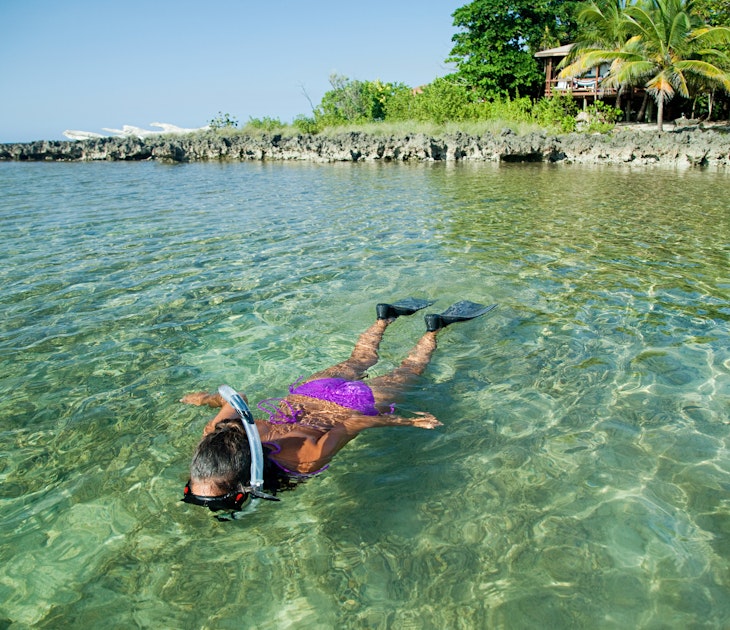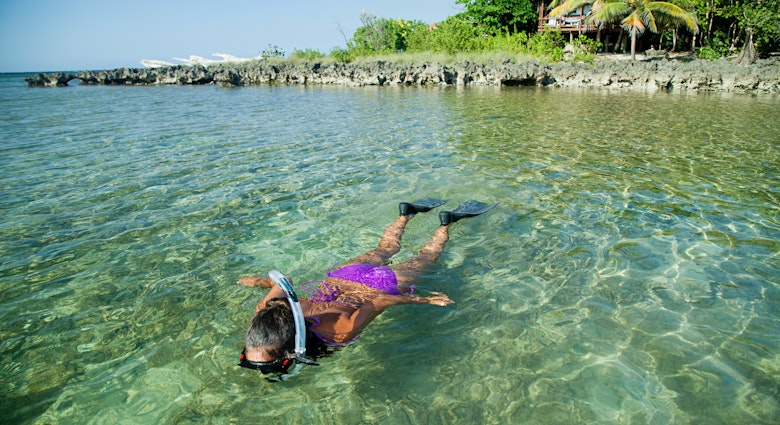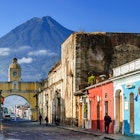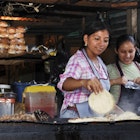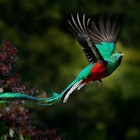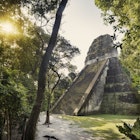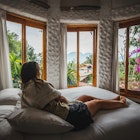A new three-day trekking route is giving local communities the chance to guide travellers deep into the Guatemalan jungle through the Maya Biosphere Reserve to the magnificent ruined city of Tikal, once a flourishing metropolis at the centre of the Maya civilisation. Lonely Planet Traveller went to test it out.
A cool breeze sweeps across the surface of Lake Petén Itzá and over the island town of Flores. It’s early morning and the streets are waking up, slowly filling with market sellers, larking schoolchildren and the buzzing of tuk-tuks. Soft light brings a glow to the red-roofed houses painted in yellows, greens and blues, and all doubled in the reflection of the wavering lake.
With its cobblestoned alleys and gently lapped waterfront, Flores is a picture of serenity, so it’s hard to imagine that the surrounding island in northern Guatemala was once host to the bloody final act of the centuries-old Maya civilisation.
Throughout the 17th century, Spanish conquistadors waged a merciless campaign across the Americas and on the morning of 13 March 1697, they descended on Flores, stronghold of the last undefeated Maya clan, the Itza. On Lake Petén Itzá, Maya warriors in dugout canoes stood to shoot reed arrows against the musket fire of a Spanish galleon. Hopelessly outmatched, the Itza were massacred. Any survivors abandoned the island and swam to safety across the lake that still bears their name.
This battle brought an end to 2,000 years of Maya rule, a civilisation that stretched from modern-day southern Mexico across Guatemala and Belize, into western Honduras and northern El Salvador.
In Flores today, there is no sign of the Itza, their former island home now prized for the colonial architecture built by their conquerors. Spanish red-tiled roofs, shaded squares and soaring Catholic cathedrals are to be found across Guatemala, most notably in the Unesco-protected, rebuilt old town of Antigua in the country’s south. Antigua grew to become the colonial capital, with a university, hospitals, printing presses and as many as 38 churches built using indigenous labour. On 29 July 1773, a power greater even than the conquistadors’ would destroy much of it – a massive earthquake. A year later, the capital was transferred to Guatemala City.

Day 1: trade routes from Cruce Dos Aguadas
Throughout the jungles of northern Guatemala, there are places where vestiges of the old pre-colonial ways remain, in crumbling edifices of stone and in the fiercely kept traditions of Maya descendants. Not far from Flores is Cruce Dos Aguadas, a dusty village of tin-roofed houses and scratching chickens. Here begins a new walking trail that follows the trade routes of the ancient Maya east through thick jungle to the ruined citadel of Tikal, using local guides from the surrounding communities.
Guides strap bedding, food and water for the three-day trek onto the backs of two sturdy horses. We disappear under the jungle canopy along trails where Maya tree-sap gatherers transported their wares and warriors once marched, their armour made of cotton vests packed with rock salt.
Leading the way is our guide Cristóbal Coc Maquín. He has walked these trails since he was a boy, when he would hunt for plants and herbs with his father, a revered local medicine man. ‘Back in the old days,’ he says, ‘there were no doctors, no pharmacies. The Maya knew how to cure themselves with the help of the forest, and we still do it today.’

As he walks, he points out plants and flowers, explaining their uses. There’s cordoncillo hembra, whose heart-shaped leaves can be boiled to soothe toothache or to draw the poison from a snake bite; wild oregano, used to treat earache; and bejuco balsámico, a vine good for arthritis. ‘These herbs are so much better than modern medicines,’ says Cristóbal. ‘The plants are powerful and you get the full benefit when you pick them yourself from nature.’
This jungled expanse is in the midst of the Maya Biosphere Reserve, 7,100 square miles of protected tropical rainforests stretching along the northern border of Guatemala. This region was once settled by a population of between two and ten million Maya, depending on which archaeologist you believe. Today, it’s home to hundreds of species of animals, from the spider monkeys who soon appear in the trees to the ever-elusive jaguar. The canopy is alive with heady birdsong, accompanied by the scrabble of hidden creatures on the ground.
We traverse the final miles to our camp. As the afternoon mellows into dusk, the cheerful chorus of birdsong reaches its finale and a high-pitched, chainsaw buzzing of insects begins, heralding the appearance of a million stars.

Day 2: exploring El Zotz
The call of a howler monkey rings out across the jungle, a guttural bellow that echoes through the trees. I am watching dawn break from the top of a vertiginous stone pyramid ruin, a two-hour detour by torchlight from the main track.
Some 1,200 years ago, this vantage point overlooked the thriving Maya metropolis of Pa’Chan, an important trading city with palaces, temples and monuments. Today, the site is almost entirely hidden, the mighty stone buildings strangled and engulfed over centuries by the inching advance of the jungle. Now known as El Zotz, the area was only discovered by archaeologists in 1978, and while some buildings have been partially excavated, most remain as they were found: knotted with vines and creepers, barely discernible from the surrounding landscape.
Patrociño Lopez Ortiz, a wiry 57-year-old park keeper, greets us with a hand raised to shield his eyes from the rising sun. He is responsible for warding off vandals and thieves in search of artefacts, though he admits this hasn’t been a problem since the ’70s. ‘I work here because I love to protect this site,’ he says. ‘Of course, I need the money to survive, for my family, but if I didn’t I would still come here to guard over this place. It’s the heritage of my country.’
As we trek further, it becomes clear how remote and unexplored this area is: the landscape is dotted with ancient structures yet to be uncovered. Once a busy road, the narrow path we’re now walking seems to disappear altogether as the jungle thickens. In hushed tones, barely audible above the forest’s thrumming cacophony, Cristóbal tells me that it’s in these deepest parts of the jungle that some of the Maya’s most feared creatures stalk their prey. Travellers must keep their eyes peeled for the sisimite, a ghoul who lures victims and steals their powers of speech. Or the siguanaba, a woman spirit with pendulous breasts and the face of a horse, who feasts on men’s souls. ‘Just 10 days ago, one of the men in the campsite woke us up screaming, saying a siguanaba was grabbing him,’ Cristóbal says gravely. ‘We rushed to help, but there was nothing there. Maybe he was dreaming.’ He shrugs. ‘Maybe not.’

Day 3: emerging at Tikal
In the heart of the Petén basin, two days’ walk from El Zotz and 50 miles from Cruce Dos Aguadas, the trail reaches its end. Like the millions of Maya before us, our journey ends in the stone city of Tikal, the centre of the Maya civilisation for over 700 years. I emerge from the clinging jungle to a shock of open space. Ahead is a neat lawn – once the Gran Plaza, surrounded by temples, causeways and former houses. It’s all overshadowed by the Temple of the Grand Jaguar, a burial pyramid built with huge blocks of limestone reaching up like a giant staircase 44 metres into the air. More monoliths dot the horizon, including the grandest of them all – Temple IV, its crest jutting above the canopy.

Archaeologist Oswaldo Gómez looks out over the stone-jumbled site he has worked on for 20 years. To understand Tikal, he explains, it’s vital to know the importance of the ancient city. This deserted plaza was once the heart of a thriving capital, with a 100,000-strong population, a centre for sporting events, festivals and public sacrifices to the gods. ‘Tikal was like New York City for the USA,’ he says, ‘or Paris for France. It was the most important centre of Maya civilisation during the Classic period – the superpower of its day.’
Then suddenly, around the year 900 AD, Tikal was abruptly abandoned, for reasons that still escape historians (though theories abound, ranging from climate change to an epidemic and even a mass alien abduction). The fall of Tikal is considered the end of the Maya’s greatest period; what followed was several hundred years of decline until that bloody defeat on the shores of Flores.
Christa Larwood is a regular writer for Lonely Planet Traveller and arachnophobe, lucky not to spot a single spider in the jungle.
To subscribe to Lonely Planet Traveller magazine in the UK, click here.
